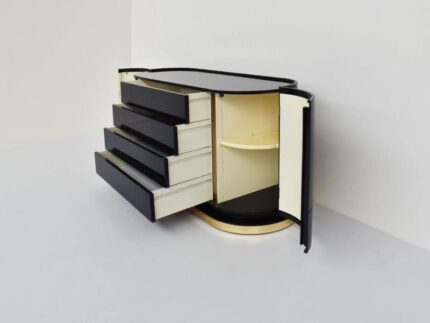Minton was one of the pioneers of English china production alongside other great potters such as Spode, Davenport, Ridgway, Coalport and others. They were located in Staffordshire and were known specifically for their wonderfully fine white bone china and bright colors; there is a color called “Minton Blue” which is a fresh azure blue that Minton excelled in. Minton supplied huge quantities of tablewares, tiles, and other items to the USA in the 19th century; the White House was traditionally supplied with Minton crockery and many great buildings of this era were tiled with Minton tiles.
These items were created in Minton’s famous parian porcelain, which is very smooth and beautifully modelled. The color is a mix of white and wonderfully soft celadon; this means that the porcelain itself is colored, creating a very dense effect.
Venus is seated in a shell, her little son Cupid hugging her from behind and her shroud fluttering in the wind rather than covering her. Two mermaids hold the shell up while playing the harp. Cupid looks like he has either just kissed Venus on the lips, or is going to, and she is looking at him with a slight expression of incredulity – is this motherly love, or has Cupid just told her who she has fallen in love with?
The figure is made with exceptional class, care and detail; not only the figures, their facial expressions, their hands and feet; but also the shell bobbing in the frothy waves and the little mermaids with their harps.
The group is unmarked, which is not uncommon for that era. We know from documentation that this design was brought out in 1861.
Condition report: The group is in perfect antique condition except a few very light scrapes to the wings of cupid and the tails of the mermaids – otherwise there is no wear, damage or any other blemish.
Antique British porcelain is never perfect. Kilns were fired on coal in the 1800s, and this meant that china from that period can have some firing specks from flying particles. British makers were also known for their experimentation, and sometimes this resulted in technically imperfect results. Due to the shrinkage in the kiln, items can have small firing lines or develop crazing over time, which should not be seen as damage but as an imperfection of the maker’s recipes, probably unknown at the time of making. Items have often been used for many years and can have normal signs of wear, and gilt can have signs of slight disintegration even if never handled. I will reflect any damage, repairs, obvious stress marks, crazing or heavy wear in the item description but some minor scratches, nicks, stains and gilt disintegration can be normal for vintage items and need to be taken into account.
There is widespread confusion on the internet about the difference between chips and nicks, or hairlines and cracks. I will reflect any damage as truthfully as I can, i.e. a nick is a tiny bit of damage smaller than 1mm and a chip is something you can easily see with the eye; a glazing line is a break in the glazing only; hairline is extremely tight and/or superficial and not picked up by the finger; and a crack is obvious both to the eye and the finger.
Dimensions: 23 x 19cm (9″ x 7.5″) and 24cm (9.5″) high.
-
Creator:Minton(Maker)
-
Dimensions:Height: 9.5 in (24.13 cm)Width: 9 in (22.86 cm)Depth: 7.5 in (19.05 cm)
-
Style:Victorian(Of the Period)
-
Materials and Techniques:Porcelain
-
Place of Origin:England
-
Period:1860-1869
-
Date of Manufacture:1861
-
Condition:GoodWear consistent with age and use. In perfect antique condition without any damage, repairs or wear other than some minor scrapes to the wings of Cupid and the tails of the mermaids.
-
Seller Location:London, GB
-
Reference Number:Seller: LT-MIN08Seller: LU4805120732272

















































Reviews
There are no reviews yet.